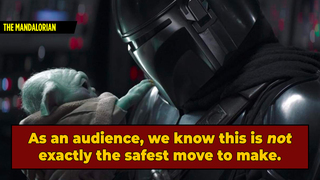That Cameo in 'The Mandalorian' Was Sad (But Not Because of the CGI)

This article contains SPOILERS for season two of The Mandalorian.
Aside from seeing Bib Fortuna and his newly swollen, presumably gout-filled scalp-tendrils, the most buzzed-about cameo in the season finale of The Mandalorian was friggin' Luke Skywalker -- not old and haggard like he was in The Last Jedi, but young, vibrant, and as lifelike as the dead-eyed passengers of The Polar Express.
Putting aside its jankiness, this moment has seemingly divided Star Wars fans; specifically, a lot of people saw the scene as a kind of repudiation of The Last Jedi. Finally, we get to see Luke Skywalker kicking ass, not bitterly moping around an island full of lactating sea monsters! But if you're willing to dig a little deeper, this scene arguably compliments the sequel trilogy.
Don't Miss
While it could be read as a triumphant act of badassery for Luke, we do get a few hints that the scene is actually more of a bummer than you might expect. For starters, the score isn't full of triumphant brass but instead creates more of a somber, almost mournful, tone.
That's because, as fun as it may be to see Luke Skywalker in action again, this ultimately isn't a good thing for our characters. Mando has spent two seasons trying to shepherd Baby Yoda to the safety of a Jedi -- but as an audience, we know this is not exactly the safest move to make. While we don't have many specifics, we do know that Luke's Jedi Academy eventually burns to the goddamn ground. So it would feel wrong to fully cheer on his taking guardianship of Grogu, just like it would be weird to cheer on Kiefer Sutherland purchasing a Christmas tree. The show reminds us of this in subtle ways. Many fans pointed out the similarities between Luke's cameo and the Vader hallway fight at the end of Rogue One.
But that too is kind of depressing. After all, we don't want Luke to be like his father, right? Very pointedly, Luke shows up wearing the same black outfit he wore in Return of the Jedi -- not because the creators of The Mandalorian couldn't be bothered to think of a new costume, but because they're piggybacking off of its previous thematic usefulness. In Jedi, Luke's black robes are very much used to hint at his potential to fall to the Dark Side. And, like in The Mandalorian, his most badass scenes recall the actions of Vader; he Force-chokes the Gamorrean Guards --


And warns Jabba not to "underestimate" his power --


In the end, Luke's ultimate act of heroism isn't to be a tough guy; it's knowing when to reject violence and anger. He saves the galaxy, not by slicing dudes in half while doing Gymkata, but by throwing his lightsaber away and refusing to execute his dad. By utilizing these same visual cues, The Mandalorian is, in essence, showing us that Luke's conflict, realistically, never ended. He's still battling the same demons he did in Return of the Jedi -- and while he may be winning, that doesn't mean that they're gone forever. And it's that same conflict that ultimately paves the way for the downfall of his Jedi Academy, when he momentarily considers killing his nephew to save the galaxy.
The folks behind The Mandalorian are clever enough to know that this scene could potentially have a two-pronged effect; pleasing all those fans who loathed The Last Jedi and wanted Luke to look and act more like a Playstation 2 version of John Wick while also working on a whole other level for audiences willing to invest in the symbolism of the franchise.
You (yes, you) should follow JM on Twitter! And check out the podcast Rewatchability.
Top Image: Lucasfilm